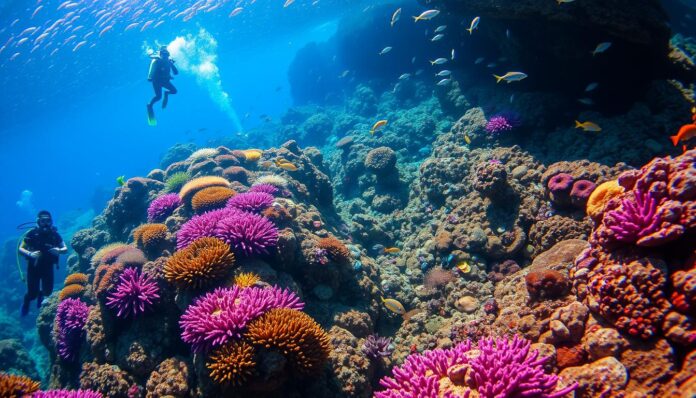| Best Time to Travel | October to May |
| What to Expect | Warm water, clear visibility, diverse marine life |
| Diving Conditions | Year-round, but best from October to May |
| Marine Life | Devil rays, turtles, sharks, dolphins, fish |
Are you ready to explore an underwater paradise few have seen? Saint Helena, a remote island in the southern Atlantic, offers a unique diving adventure.
Imagine diving into clear waters teeming with marine life. Here, historic shipwrecks share stories of the past. Scuba diving in Saint Helena is more than a vacation—it’s an expedition to a unique marine world.
Located 1,200 miles from Africa’s west coast, Saint Helena offers a chance to see unexplored marine ecosystems. The water is warm, ranging from 19°C to 26°C. Underwater visibility is excellent, from 15 to 25 metres, making it a top diving spot all year.
Key Takeaways – Scuba Diving in Saint Helena
- Discover one of the most remote diving destinations in the world
- Explore pristine marine environments with exceptional visibility
- Encounter unique marine species found nowhere else on the planet
- Dive among historic shipwrecks with rich maritime stories
- Experience year-round diving in clear, warm waters
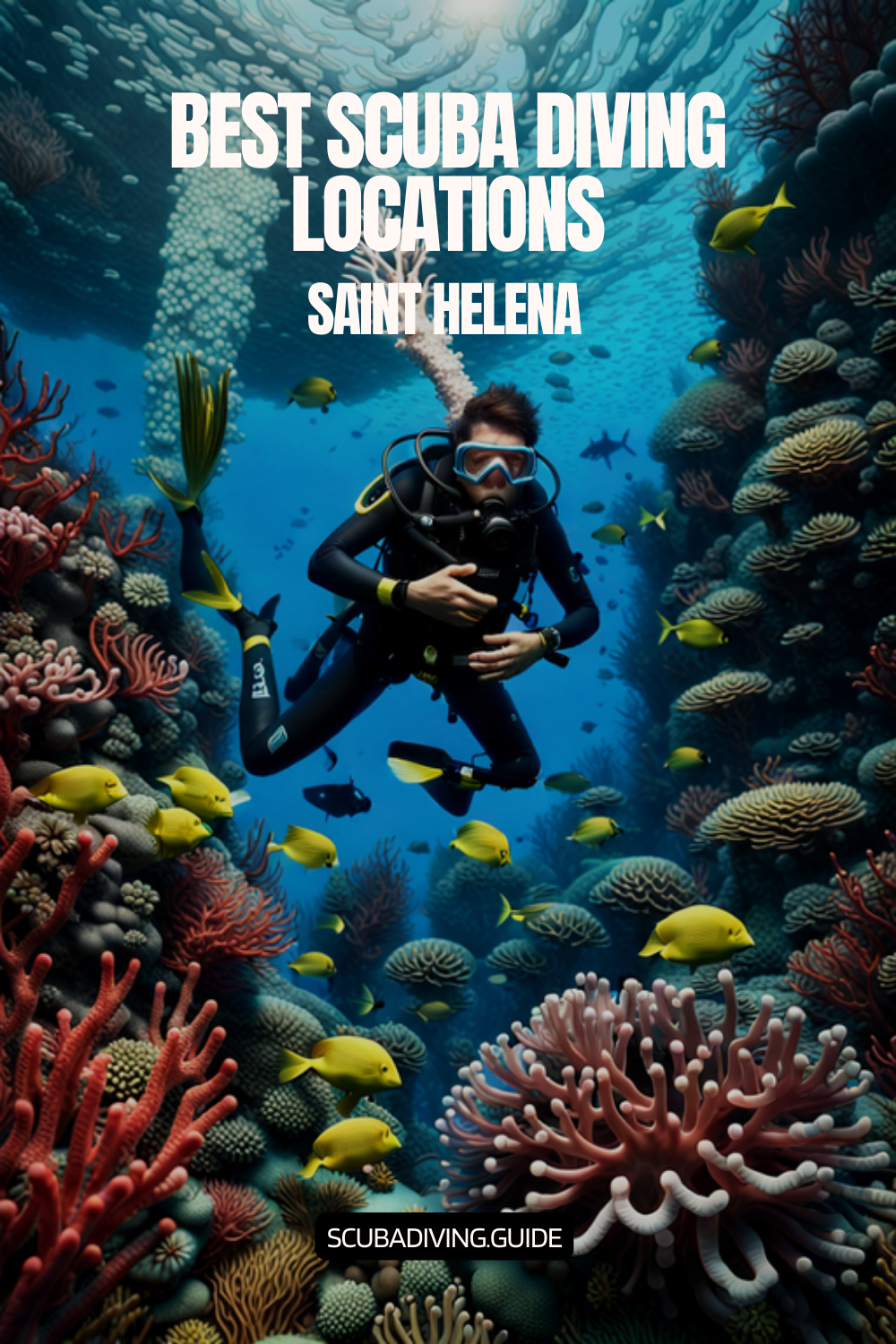
Overview of Scuba Diving in Saint Helena
Saint Helena has an amazing underwater world that few have seen. This island in the South Atlantic has a unique marine ecosystem. It draws scuba lovers looking for unique Saint Helena Marine Life experiences.
What Makes Saint Helena a Unique Diving Destination?
The island has an incredible underwater environment. It has:
- Over 780 marine species identified
- 50 endemic species found nowhere else worldwide
- Designated Category VI Marine Protected Area
- Pristine waters with exceptional visibility
“Saint Helena represents a hidden gem for underwater explorers, with unparalleled marine biodiversity.” – Marine Conservation Expert
Best Time to Dive in Saint Helena
Photography lovers will find the best diving all year. The water is warm, between 20-28°C, making dives comfortable.
| Diving Conditions | Details |
|---|---|
| Water Temperature | 20-28°C |
| Visibility | Up to 40 meters |
| Average Dive Depth | 11 meters |
Peak diving seasons are great for seeing amazing marine life. You might see devil rays and unique species like the orange cup coral. Always keep at least 3 meters away from whale sharks to protect them.
Top Dive Sites in Saint Helena
Saint Helena has an amazing underwater world that draws scuba diving fans from everywhere. The island’s unique sea floor offers a wide range of dive experiences. You can explore historic shipwrecks or dive into vibrant coral gardens full of marine life.
Jacques Cousteau’s Legendary Diving Locations
Jacques Cousteau called Saint Helena’s underwater world a hidden treasure. His dives highlighted incredible sites that now attract divers looking for unique experiences.
- Lighter Rock: A top dive spot with clear visibility
- James Bay: Home to a rich marine ecosystem and varied underwater landscapes
- Deep-water sites with unique marine species
Historic Shipwrecks Beneath the Waves
Saint Helena has many diveable shipwrecks that share interesting maritime stories. These underwater relics give divers a peek into the past.
| Wreck Name | Year Sunk | Depth Range |
|---|---|---|
| Papanui | 1911 | 6-12m |
| Darkdale | 1941 | 18-28m |
| Witte Leeuw | 1613 | 33m |
Coral Gardens and Marine Biodiversity
Exploring Saint Helena’s underwater world reveals incredible marine ecosystems. You’ll see unique species like the St Helena butterflyfish, which swim in large schools.
“Saint Helena offers an underwater paradise that remains largely undiscovered by mainstream diving communities.” – Marine Exploration Magazine
Dive depths in Saint Helena range from 8 to 50 meters, appealing to both new and seasoned divers. The island’s clear waters, thanks to minimal sediment runoff, offer visibility up to 50 meters. This makes it a perfect place for diving.
Equipment Rental and Dive Shops
Saint Helena offers a unique diving experience with well-equipped dive shops. The island’s remote location makes professional dive services key for visitors. They help explore its remarkable underwater world.
Diving on Saint Helena needs careful preparation. Local dive operators provide full support for marine explorers.
Recommended Dive Shops on the Island
Two main dive operators serve the island:
- Sub-Tropic Adventures (established in 2000)
- Into The Blue Dive Center
Equipment Rental Prices and Options
Divers can rent professional-grade equipment with clear prices. The standard dive package includes:
- Steel 12-liter cylinders
- Weights and weight belts
- Compatibility with DIN and A-clamp regulators
Rental prices are simple, with dives at £40 GBP per session. This includes all essential equipment.
Dive Boat Specifications
| Specification | Details |
|---|---|
| Boat Type | RIB (Rigid Inflatable Boat) |
| Maximum Capacity | 12 clients |
| Typical Dive Depths | 6-40 meters |
“Saint Helena’s dive operators bring years of local experience to ensure safe and memorable underwater experiences.” – Local Dive Expert
Saint Helena Dive Resorts focus on safety, quality equipment, and personal diving experiences. Whether you’re new or experienced, the island’s dive shops are ready to support your underwater adventure.
Dive Certifications in Saint Helena
Scuba Diving in Saint Helena is a unique chance to get professional diving certifications. The island has top-notch diving education for all levels. Whether you’re new or experienced, you can get your Saint Helena Scuba Certification here.
There are many certification paths to choose from, thanks to recognized international agencies. PADI is the main provider on the island.
Recognized Certification Agencies
Specialized dive training facilities in Saint Helena offer detailed certification programs. You can choose from:
- PADI Open Water Diver Course
- PADI Advanced Open Water Diver Course
- PADI Rescue Diver Certification
- Emergency First Response Course
Certification Requirements and Options
There are different certification levels based on your experience and goals:
| Certification Level | Age Requirement | Maximum Depth |
|---|---|---|
| Junior Scuba Diver | 10-14 years | 12 meters |
| Open Water Diver | 15+ years | 18 meters |
| Advanced Open Water | 12+ years | 30 meters |
Getting Certified While Vacationing
Dive Saint Helena offers certification courses all year. It’s perfect for those who want to dive and vacation at the same time. The marine environment is stunning, with clear waters and warm temperatures.
“Learning to dive in Saint Helena isn’t just a certification—it’s an adventure in one of the world’s most pristine marine ecosystems.”
Visitors can finish courses in just a few days. This makes it easy to get certified while enjoying a tropical getaway. The training covers underwater skills, marine conservation, and diving in different conditions.
Dive Conditions and Safety
Scuba diving in Saint Helena needs you to know the marine environment and safety rules. The island’s remote spot has amazing diving sites. These sites are known for their unique underwater conditions, drawing divers from everywhere.
Understanding Marine Currents
The marine life around Saint Helena has different current challenges for divers. The windward side has currents of 3-5 knots. The leeward side is calmer, with little to no current.
- Windward side currents: 3-5 knots
- Leeward side: Minimal to no current
- Recommended experience level: Intermediate to advanced divers
Water Conditions for Saint Helena Dive Trips
The diving conditions in Saint Helena are top-notch. Water temperatures are between 24-26°C during the best diving months. Visibility can be amazing, up to 40-45 meters in February and March.
| Parameter | Details |
|---|---|
| Water Temperature | 24-26°C |
| Underwater Visibility | 30-45 meters |
| Peak Diving Season | January to June |
Essential Safety Tips for Divers
When diving in Saint Helena, safety is key. Always:
- Check your gear before diving
- Dive with local guides who know the area
- Know the current patterns
- Make sure you’re certified for the dive
- Stick to safe diving depths
“The underwater world of Saint Helena offers unparalleled diving experiences for those who respect its natural rhythms.” – Local Dive Instructor
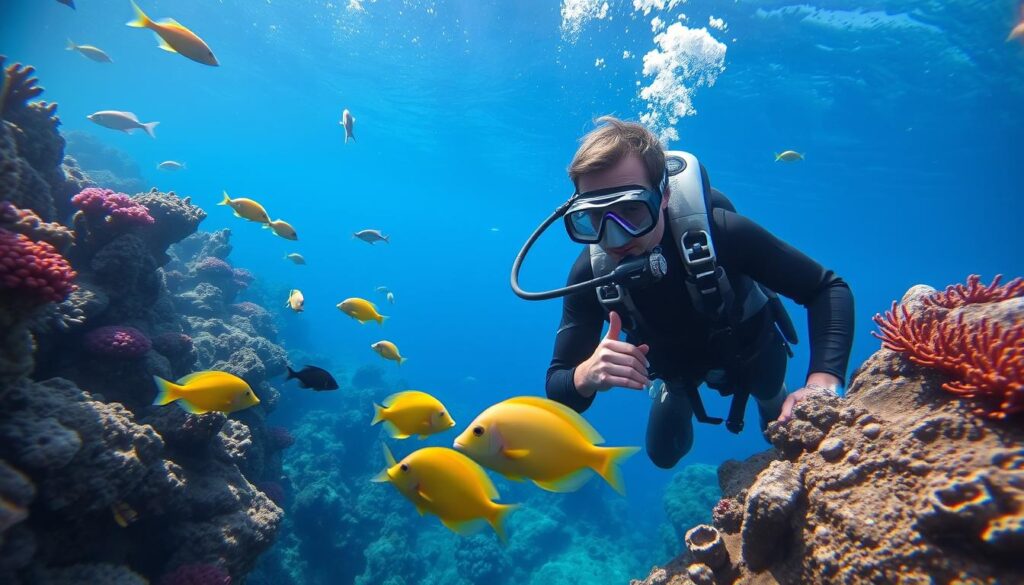
By knowing these conditions and following safety rules, divers can have a memorable dive in Saint Helena’s beautiful marine world.
Marine Life Encountered While Diving
Saint Helena Marine Life offers an extraordinary underwater experience for divers. The island’s waters are home to diverse and fascinating creatures. This makes Saint Helena Underwater Photography a dream for marine enthusiasts.
Diving in Saint Helena reveals a remarkable ecosystem. It has many endemic and migratory species. The waters host an impressive array of marine creatures that captivate underwater explorers.
Common Marine Species to Discover
- Rare Flameback angelfish spotted at Egg Island, Torm’s Ledge, and Speery Island
- Endemic St Helena butterflyfish, forming schools of over 1,000 individuals
- Marmalade razorfish, globally rare but common around St Helena
- Wahoo fish growing up to 2 meters in length
Spectacular Dolphin and Ray Encounters
| Species | Characteristic | Typical Observation |
|---|---|---|
| Rough-toothed Dolphin | Up to 3 meters long | Small pod encounters |
| Pantropical Spotted Dolphin | Groups of 200-300 | Pods exceeding 400 individuals |
| Chilean Devil Ray | Maximum width 3.7 meters | Seasonal migrations |
Seasonal Marine Events
Saint Helena offers extraordinary marine spectacles throughout the year. Whale sharks aggregate between December and March. This can mean more than 30 individual sharks visible in a single day. Humpback whales grace the waters from June to December, providing breathtaking wildlife interactions.
“Saint Helena’s marine ecosystem is a hidden treasure, providing divers with unparalleled encounters with rare and magnificent sea creatures.”
Divers can expect water temperatures around 75°F. Dive durations average 58 minutes. The island’s unique marine environment ensures an unforgettable underwater adventure for those passionate about exploring marine biodiversity.
What to Expect During Your Dive
Scuba diving in Saint Helena is an amazing underwater adventure. It’s perfect for divers of all levels. The island’s marine world offers unique experiences for both new and seasoned explorers.
Dive Duration and Depth Levels
Divers will find incredible experiences with dives from 10-18 meters deep. The dives last 45-60 minutes, giving plenty of time to see the marine life. The water is warm, ranging from 18-25 degrees Celsius, making diving comfortable.
- Average dive depth: 10-18 meters
- Typical dive duration: 45-60 minutes
- Water temperature range: 18-25°C
- Visibility: 15-20 meters on most days
Guided vs. Solo Diving Experiences
Saint Helena advises diving with a guide for safety and to see more. Local dive operators offer small groups for a more personal experience. They guide you through the island’s stunning underwater world.
“The magic of Scuba Diving in Saint Helena lies not just in what you see, but how you experience it.”
Professional Marine Tour Operators provide great dive packages. They include:
- Comprehensive pre-dive briefings
- High-quality equipment rental
- Expert local guide navigation
- Safety protocols and marine conservation insights
For an unforgettable underwater journey, Saint Helena dive trips are unmatched. You can see up to 40 meters of visibility during peak seasons. Divers will see vibrant marine life with over 700 species, making the dive unforgettable.
Photography Tips for Underwater Scuba Diving
Saint Helena Underwater Photography takes you into a magical world beneath the waves. It’s all about capturing the vibrant marine life. You need skill, patience, and the right gear to do it.
Photographing Saint Helena Marine Life is a special task. The clear waters are perfect for underwater photos.
Best Cameras for Underwater Photography
Choosing the right camera is key for underwater shots. Here are some top picks:
- Compact Point-and-Shoot Cameras: Great for beginners
- Mirrorless Cameras: Perfect mix of size and quality
- DSLR Cameras: Top-notch for professionals
Techniques for Capturing Marine Life
Learning underwater photography takes practice. Here are some tips:
- Always use natural light
- Get up close to your subject
- Stay steady in the water
- Position your strobe correctly
| Camera Type | Pros | Best For |
|---|---|---|
| Compact Camera | Affordable, Lightweight | Beginners, Casual Photographers |
| Mirrorless Camera | High Quality, Compact | Intermediate Photographers |
| DSLR with Housing | Professional Image Quality | Advanced Underwater Photographers |
“Underwater photography is about capturing moments of marine grace and beauty.” – Professional Underwater Photographer
More tips for Saint Helena Underwater Photography include using red filters. This helps restore color. Also, keep a respectful distance from marine creatures. Remember, patience and practice are essential for amazing underwater photos.
Environmental Considerations
Saint Helena’s marine ecosystem is a pristine underwater world that needs careful preservation. The island is a global leader in marine conservation. It works hard to protect marine biodiversity.
The marine life in Saint Helena is unique. The island’s Marine Protected Area (MPA) is one of 156 global Hope Spots. This shows how important it is to save marine environments.
Conservation Efforts in Saint Helena
The island has strong conservation strategies for its marine ecosystem. Key efforts include:
- Creating a detailed Marine Management Plan
- Joining the UK Government’s Blue Belt Programme
- Using sustainable fishing practices
- Protecting unique marine species
How Divers Can Help Protect Marine Life
Responsible Scuba Diving in Saint Helena means helping with conservation. Divers can help by following these tips:
- Keep proper buoyancy to avoid coral damage
- Avoid touching marine life or disturbing habitats
- Use reef-safe sunscreen
- Join local conservation programs
| Conservation Regulation | Specific Requirements |
|---|---|
| Dive Site Limits | Maximum 20 divers per site |
| Boat Restrictions | Maximum 2 boats per site in 24 hours |
| Photography Rules | Flash photography prohibited with marine megafauna |
“Protecting our marine environment is not just a responsibility, it’s a privilege.” – St Helena Marine Conservation Team
Divers can help keep Saint Helena’s marine ecosystem safe for the future. By following these principles, they play a big role in conservation.
Accommodations Near Dive Sites
Scuba diving fans looking for the best place to stay in Saint Helena have many options. The right Saint Helena Dive Resorts can greatly enhance your diving experience.
When planning your diving trip, it’s important to be close to Saint Helena Dive Shops. The island has many places to stay that meet the needs of divers:
Top Recommended Lodging for Divers
- Mantis Hotel: Premium diving package option
- Self-catered B&B accommodations
- Budget-friendly guesthouses near dive sites
Accommodation Packages and Pricing
| Accommodation Type | Price (per person) | Inclusions |
|---|---|---|
| Mantis Hotel Package | £2,295 | 7 nights, 5 days of two-tank morning dives, whale shark snorkels, island tour |
| Self-Catered Option | £1,705 | Basic accommodation with diving flexibility |
Strategic Location Benefits
Staying near dive shops has many benefits:
- Easy gear storage and maintenance
- Quick access to early morning dive departures
- Immediate support from local diving experts
*”Your accommodation can be the difference between a good diving trip and an extraordinary diving experience.”*
With dive costs at £40 per dive and packages starting from £1,805, Saint Helena offers great value. It’s perfect for those seeking a unique underwater adventure.
Local Culture and Community
Saint Helena offers a unique diving experience that goes beyond underwater exploration. The island’s vibrant marine community creates an immersive environment for Scuba Diving in Saint Helena. It attracts enthusiasts from around the globe.
With a population of just 4,439 residents, Saint Helena boasts an incredibly tight-knit diving culture. The local Dive Club represents the heart of marine engagement. It organizes weekly activities and annual events that welcome both residents and visitors.
Engaging with Local Dive Enthuasiasts
Visitors participating in Saint Helena Dive Trips can expect warm welcomes from passionate local divers. The community’s dedication to marine conservation creates unique opportunities for interaction:
- Weekly group dive expeditions
- Community marine education workshops
- Endemic marine species identification programs
- Conservation awareness events
Community Events Related to Diving
Saint Helena’s diving community hosts several exciting annual events. These events showcase their commitment to marine ecosystems:
| Event Name | Purpose | Month |
|---|---|---|
| Whale Shark Festival | Marine Conservation Awareness | January |
| Ocean Cleanup Challenge | Environmental Protection | April |
| Marine Species Symposium | Scientific Research Sharing | September |
“Our marine community isn’t just about diving—it’s about protecting and celebrating our extraordinary underwater world.” – Local Dive Club Representative
The island’s commitment to sustainable marine tourism ensures that every Saint Helena Dive Trip supports local conservation efforts. It provides unforgettable underwater experiences.
Top Attractions Beyond Scuba Diving
Saint Helena is more than just a place for diving. It has a rich history and stunning natural beauty. Visitors can enjoy both the underwater world and the island’s unique land-based activities.
Exploring Saint Helena’s Historic Treasures
Longwood House is a key historical site. It was Napoleon Bonaparte’s home during his exile from 1815 to 1821. Here, you can see the rooms where he lived and learn about his final years.
- Napoleon’s Residence: Longwood House
- Exile Period: 1815-1821
- High Knoll Fort: Historical military structure
- St. Paul’s Cathedral: Built in 1851
Nature Trails and Outdoor Adventures
The island has many hiking trails called Post Box Walks. These trails range from easy to challenging, with 21 routes to choose from. Jacob’s Ladder, with its 699 steps, offers amazing views of Jamestown.
“Saint Helena is not just a diving destination, but a complete adventure paradise.” – Local Tourism Board
| Attraction | Unique Feature | Recommended Time |
|---|---|---|
| Jonathan the Tortoise | World’s Oldest Living Land Animal | Weekday Mornings |
| Diana’s Peak | Highest Point (823 meters) | Clear Weather Days |
| Plantation House | Historic Site | Tuesdays & Thursdays |
Don’t miss Jonathan the Tortoise at Plantation House. He’s about 187 years old and a living piece of history.
Whether you love diving or history, Saint Helena has something special for everyone. Its small size means you can easily explore all the amazing sights.
Planning Your Trip to Saint Helena
Planning a trip to Saint Helena for diving is key. This island offers a special diving experience. You need to think about travel and island details carefully.
Reaching the Island Paradise
To start diving in Saint Helena, know your travel options. The main way is by flying from Johannesburg, South Africa. Flights start at £780 ($990), making it a great diving spot.
- Direct flights from Cape Town
- Recommended travel season: January to March
- Flight duration: Approximately 6 hours
Travel Tips for Diving Enthuasiasts
Getting ready for Saint Helena diving needs smart planning. Here are some tips:
- Pack lightweight, quick-dry clothes
- Bring an underwater camera
- Look into dive gear rentals
| Trip Type | Price | Duration | Included Dives |
|---|---|---|---|
| Budget Trip | £1,290 (double room) | 10 days | 12 dives |
| Deluxe Trip | £1,985 (double room) | 9 days | 12 dives |
Budgeting and Accommodation
Plan your budget for Saint Helena diving trips. Car rentals start at £15 a day. Meals range from £5 for casual to £20 for fancy.
Pro tip: Book your stay early. The Mantis Hotel, with its historic buildings from 1774, is a great choice.
With good planning, your Saint Helena diving trip will be a memorable marine adventure.
Common Frequently Asked Questions
Planning your Scuba Diving in Saint Helena adventure comes with many questions. This section addresses the most common inquiries to help you prepare for an unforgettable underwater experience.
What Certifications Are Needed for Diving?
Saint Helena Scuba Certification requirements vary depending on your diving experience and skill level. Divers typically need the following certifications:
- Open Water Diver certification for beginners
- Advanced Open Water certification for more challenging dive sites
- Specialized certifications for deep or wreck diving
Most dive operators on the island recommend at least an Open Water certification. Beginners can often take introductory courses directly on Saint Helena to get certified.
Are There Age Restrictions for Scuba Diving?
Scuba diving in Saint Helena has specific age guidelines to ensure safety:
| Age Group | Diving Options |
|---|---|
| 8-12 years | Supervised junior diving programs |
| 13-16 years | Limited depth junior certifications |
| 17+ years | Full recreational diving access |
“Safety first, adventure always!” – Local Saint Helena Dive Instructor
DiveAssure programs cover divers from 8 to 80 years old, providing insurance and support for your underwater exploration in Saint Helena.
Additional considerations include:
- Medical fitness clearance
- Basic swimming skills
- Comfort in water environments
Each dive center on Saint Helena will conduct a brief assessment to ensure you’re ready for the amazing underwater world waiting to be discovered.
Diving Packages and Deals
Saint Helena Dive Trips offer great value for those who love diving. The island’s marine life is unmatched, giving divers a chance to see amazing underwater scenes.
There are many Saint Helena Dive Resorts packages to choose from. They cater to all levels of diving experience. These packages make exploring the island’s underwater world easy and complete.
All-Inclusive Diving Packages
Dive packages in Saint Helena come with amazing features. They make planning your dive trip easy:
- Return flights from Johannesburg to Jamestown
- 7 nights accommodation with breakfast
- 5 days of two-tank morning dives (10 total dives)
- 2 whale shark snorkeling experiences
- Full-day island tour
- Airport transfers
Special Offers for Groups
Booking with a group can save you money and offer special experiences. Dive packages cost between £1,400 and £2,010 per person for a week.
| Package Type | Price Range | Inclusions |
|---|---|---|
| Standard Package | £1,705 | Self-catered accommodations, basic dive experiences |
| Premium Package | £2,295 | Full accommodations, 10 dives, whale shark encounters |
| Extended Adventure | £3,545 | Dive package + African Wildlife Safari |
Pro tip: Book during the whale shark season (January to March) for an extraordinary marine encounter!
“Saint Helena offers a diving experience like no other – isolated, pristine, and absolutely breathtaking.” – Marine Exploration Magazine
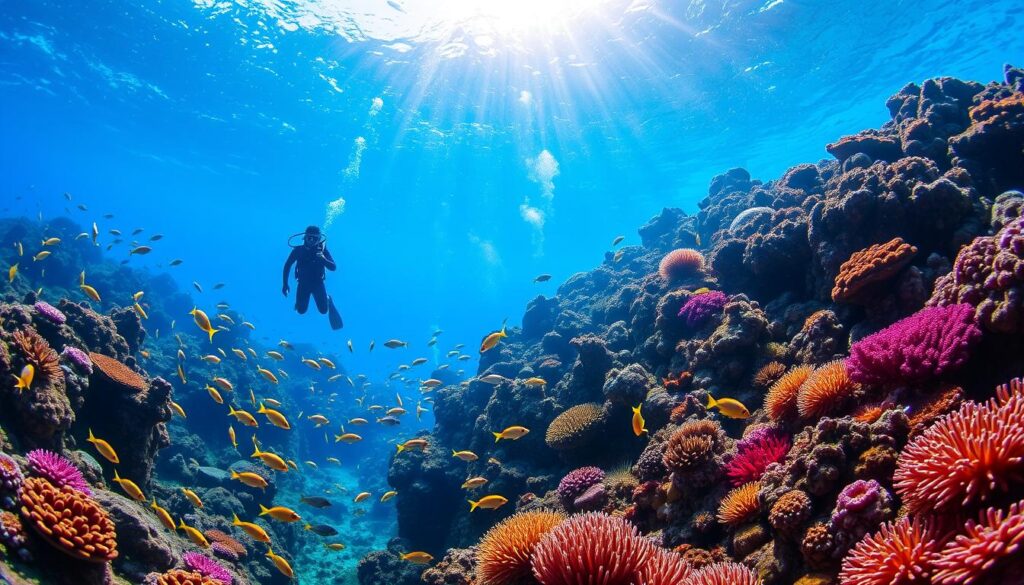
Saint Helena Recommended Scuba Diving Itinerary
To make the most of your scuba diving adventure in Saint Helena, it is recommended to plan a well-rounded itinerary that allows you to explore a variety of dive sites across the island. Here’s a suggested itinerary to help you create a memorable and fulfilling diving experience:
Day 1: Arrival and Orientation
Upon arrival in Saint Helena, settle into your accommodation and visit the local diving center to complete any necessary paperwork, rental equipment arrangements, and meet with the dive professionals. Take this time to get acquainted with the diving facilities and discuss your diving preferences and goals for the trip. Attend an orientation session to familiarize yourself with the local diving regulations and safety guidelines.
Day 2: Warm-up Dives and Skill Refresher
Begin your diving journey with a couple of warm-up dives at accessible dive sites near the coast. These dives will allow you to acclimate to the underwater environment, refresh your diving skills, and ensure that all your equipment is working properly. Dive sites such as Rupert’s Bay and Thompson’s Valley are great options for warm-up dives, offering a mix of marine life and beautiful underwater landscapes.
Day 3-5: Explore Diverse Dive Sites
Dedicate the next few days to exploring a selection of diverse dive sites that showcase the unique characteristics of Saint Helena’s underwater world. Visit sites like The Pinnacles, Sugar Loaf, and North West Point to encounter vibrant coral reefs, schools of tropical fish, and fascinating underwater topography. Take advantage of guided dives offered by the diving centers to maximize your exploration and learn more about the marine life and geological formations you encounter.
Day 6: Liveaboard Adventure
Embark on a liveaboard adventure to reach remote and less-explored dive sites that are only accessible by boat. Join a multi-day liveaboard trip that takes you to locations like Roman Wall, Halley’s Mount, and Egg Island, where you can experience the untouched beauty of Saint Helena’s marine ecosystems. Enjoy multiple dives per day, guided by experienced dive professionals, and relish the unique experience of living and diving from a floating hotel.
Day 7: Relaxation and Surface Interval
Take a day to relax and enjoy the island’s other attractions. Explore the picturesque landscapes, visit historical landmarks, or indulge in the local cuisine and culture. Use this surface interval to recharge, share stories with fellow divers, and reflect on your diving adventures so far.
Day 8-10: Advanced Diving and Specialized Sites
For experienced divers seeking more thrilling adventures, dedicate the next few days to advanced dives and specialized dive sites. Explore locations like Man and Horse, Long Ledge, and Rupert’s Bay to encounter unique rock formations, underwater archways, and the possibility of spotting larger marine species such as whale sharks (during their migration season) and humpback whales.
Day 11: Farewell Dives and Reflection
As your diving journey in Saint Helena comes to an end, embark on a few farewell dives to revisit your favorite dive sites or explore new ones. Capture the final moments of your underwater adventure, taking in the beauty and wonder of the marine world. After the dives, take time to reflect on your experiences, share gratitude with the diving professionals who guided and supported you throughout your journey, and bid farewell to the island’s breathtaking underwater realm.
By following this recommended diving itinerary, you can immerse yourself in the diverse and captivating underwater landscapes of Saint Helena, experiencing the island’s unique marine life and geological formations. Remember to always prioritize safety, follow diving regulations, and respect the delicate marine ecosystems to ensure a sustainable and enjoyable diving experience.
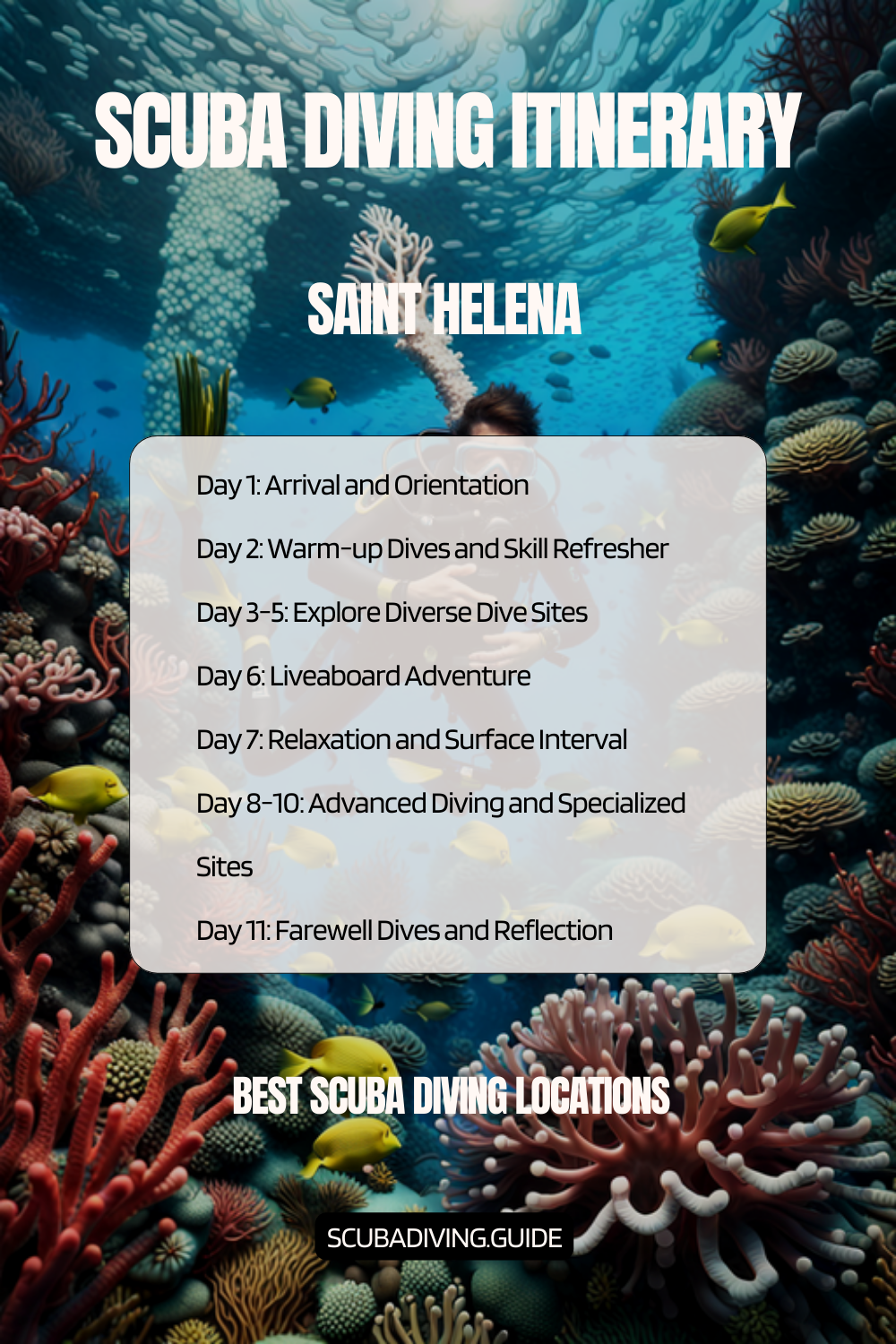
Other Countries to Consider
Conclusion: The Scuba Diving Experience Awaiting You
Scuba diving in Saint Helena is an extraordinary underwater adventure. It’s far from the usual marine experiences. This remote island is 1,200 miles from the African coast. It offers divers a chance to see some of the most untouched marine environments.
The marine life in Saint Helena is truly unique. Divers can see whale sharks from December to March. There are also 28 fish species found nowhere else. The underwater landscapes and clear waters make diving here unforgettable.
Final Thoughts on Diving in Paradise
Diving in Saint Helena is more than just a vacation. You can dive as deep as 86 feet and see water temperatures around 75°F. It’s a chance to explore historic marine environments.
The island’s remote location and friendly locals make your diving experience special. Saint Helena offers a diving journey that will change how you see marine exploration. It’s perfect for those looking for unique marine biodiversity and geological formations.
FAQ – Scuba Diving in Saint Helena
What certification level do I need to dive in Saint Helena?
For most dive sites in Saint Helena, an Open Water certification is recommended. Some advanced sites might need Advanced Open Water or similar experience. Local dive operators like Into The Blue can check your skill level and suggest the right dive sites.
When is the best time of year to dive in Saint Helena?
The best diving conditions are from November to May. During this time, water temperatures are between 68-77°F (20-25°C) and visibility is excellent. This period also sees whale shark migrations, providing a unique underwater experience.
Are there any unique marine species I can expect to see?
Saint Helena is home to endemic species like the St Helena butterflyfish and flameback angelfish. Divers can also see whale sharks, humpback whales, and a wide variety of marine life in the island’s pristine Marine Protected Area.
What equipment rental options are available?
Local dive shops like Sub-Tropic Adventures and Into The Blue offer equipment rental packages. Full gear sets cost between $30-$50 per day. You can also rent individual pieces like masks, fins, and tanks.
How challenging are the dive sites in Saint Helena?
Saint Helena has dive sites for all skill levels. There are beginner-friendly coral gardens and more challenging deep-water wreck sites. Dive operators can help find sites that match your experience and comfort level.
Do I need to bring my own dive gear?
While you can bring your own gear, local dive shops provide high-quality rental equipment. Given Saint Helena’s remote location, many divers find it easier to rent locally to avoid transportation challenges.
Are there diving certification courses available on the island?
Yes, PADI certification courses are offered by local dive centers. You can complete entry-level certifications like Open Water during your visit. It’s a great way to combine vacation with skill development.
What are the typical water conditions for diving?
Water temperatures range from 68-77°F (20-25°C), with visibility often over 100 feet. Currents are generally mild. Local dive masters can provide detailed insights into specific site conditions.
Is underwater photography recommended in Saint Helena?
Absolutely! The crystal-clear waters and diverse marine life make Saint Helena a photographer’s paradise. Local dive shops can offer advice on camera equipment and techniques for capturing the underwater world.
How can I contribute to marine conservation while diving?
Practice responsible diving by maintaining good buoyancy, avoiding contact with marine life, and participating in local conservation initiatives. Many dive operators on Saint Helena are actively involved in marine preservation efforts.
